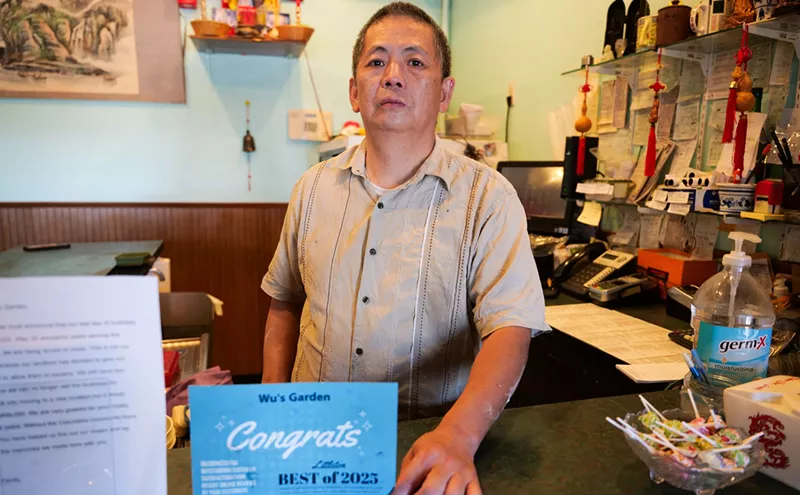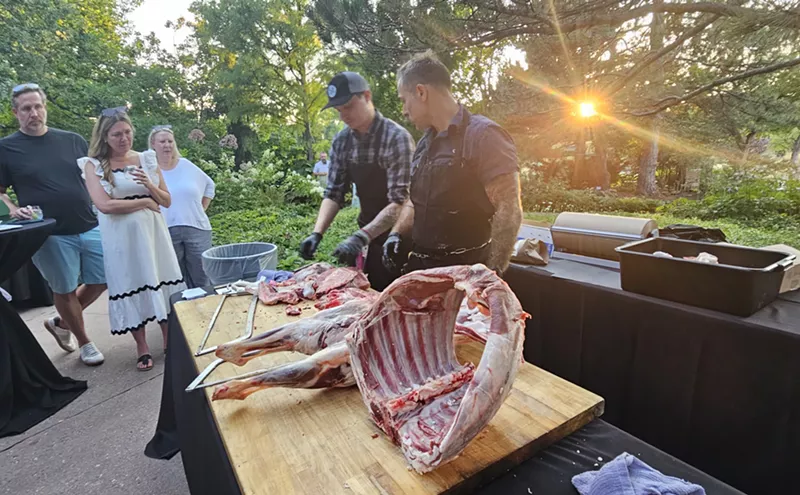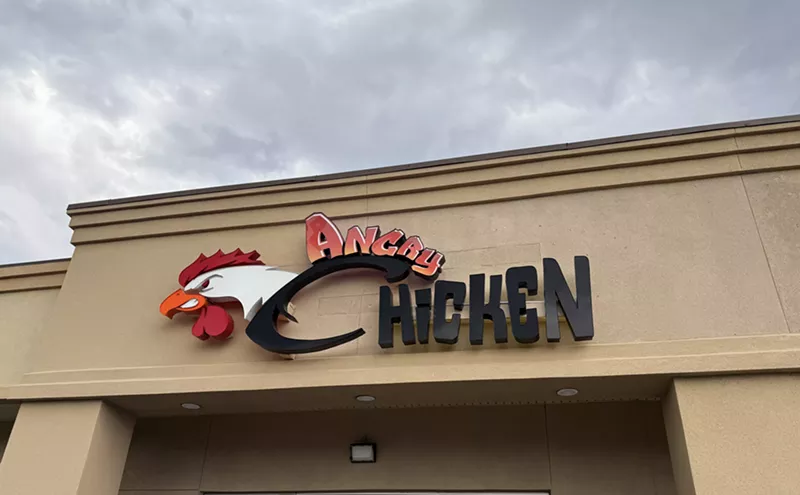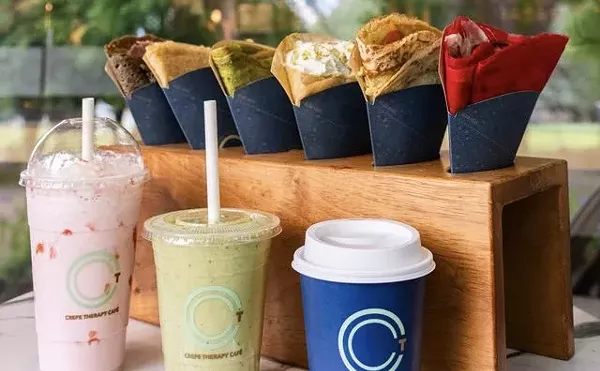Sometimes these weekly missives are about time and the progression through it of a menu, a chef, an address. Sometimes they're about history, which isn't the same as time, because time is smooth and steady, and history is, well, bumpy. History is the story of peaks and jags in time, and food often captures these chronological features quite handily.
Sometimes they're about an event. Most often they're about me, because I am afflicted somewhat with egomaniacal leanings and enjoy being the highly opinionated filter through which these many meals slip. And sometimes -- although rarely, I must admit -- they're even about the food. Food in all its myriad connections to time and space, history, people and me. When I talk about politics or culture or myth, immigration or zombie movies or punk rock, or love and lust and hatred, I'm talking about them in relation to food. And when I talk about food, I'm talking about food in relation to everything else in the world.
This week is all about the food. Which is to say it's about everything, with the food speaking so clearly and in such a rich voice that it drowns out any six-string, zombie or mythic digression. And it all begins with a quivering egg of buffalo mozzarella in which anything you need to know is neatly contained.
I've had very fresh mozzarella on only a couple of occasions, usually when it's been pressed upon me by flamingly OCD cheesemakers of the sort who insist, often violently, that fresh milk cheeses have an ideal life expectancy that is measured not in days, but in moments.
"Here!" they will shout. "Here! Eat it now! Quick, before it dies!" And then they will hand me a spoon of ricotta, a nipped bud of mozzarella still wet from the bowl, a ropy finger of queso fresco.
And they're right. There's nothing on earth quite like a very fresh cheese -- still warm from someone's hand -- for teaching you to appreciate the value of powerful and unrecoverable instants. And there's no better proof that a restaurant understands the gravity of such moments than the codifying of such an experience permanently onto a menu.
At Venice Ristorante -- the new Venice Ristorante, in LoDo -- the fresh-cheese gimmick is worked nightly on the Campania regional tasting menu. Course one, insalata di rucola e pomodori: tender, beautiful leaves of baby arugula dressed in balsamic vinegar from Modena, soft Tropea onions, tomatoes, green olives and two half-orbits of delicate buffalo mozzarella so young that its middle is just one step removed from liquid and its surface puckered around individual grains of salt and shards of black peppercorn.
Course two, mozzarella caprese: sliced and quartered tomatoes, sweet Italian basil, dried oregano and Tuscan olive oil with cow's-milk mozzarella, stiffer and older, slightly matured -- by minutes, maybe, hours at the most.
Course three, ravioli parmigiana: handmade ravioli filled with liquid buffalo mozzarella shot through with puréed tomato and ripened with aged parmesan. The ravioli are bathed in a gorgonzola cream sauce, its depth and muscle coming from the veins of mold allowed to develop in the gorgonzola over months, sometimes years, and opened by the knife and the heat of the pan. Course three is the antithesis to course one, showcasing the strength, complexity and wily strata of flavor bestowed by age, how the old can shape and bolster the new. And it is, of course, unconscionably delicious -- the kind of thing you just want to eat and eat until you die, a flavor so composed and haunting that the more you consume, the hungrier you get.
Thus, time and age as described by food. And Venice itself -- the room, the restaurant, the name -- as descriptor of a very personal and specific history: both Denver's and mine.
Owner Alessandro Carollo's first restaurant -- his first Venice, opened five years ago on Yosemite Street in Greenwood Village -- was the first place I reviewed in Denver. I loved it in part, if not in full, and was absolutely intrigued by the gut-punch honesty of the food and the overspilling crowds it attracted.
Soon after Carollo opened Venice, Adega -- the hugely expensive, hugely ambitious and (almost) unerringly brilliant home of chef Bryan Moscatello -- debuted at 1700 Wynkoop Street. Adega was the restaurant that put Denver on the 21st-century food map, the place that ushered in the city's grubnik, white-tablecloth renaissance.
Flash forward four and a half years. Adega is gone, Moscatello is cooking collards and grits on the East Coast, and Carollo now oversees a family of three restaurants. To accommodate the crowds, he opened a second Venice, on South Holly in Greenwood Village, and turned his original restaurant into Chianti. And then in 2005, he took over Adega's abandoned home and opened his newest, biggest and most impressive restaurant yet. Christian Delle Fave stands the exec's post here as he did at the original Venice, with chef Gustavo Amaro running the service from the line.
To my eye, this new Venice does not yet fully inhabit Adega's old space; it seems to be acting almost like a temporary caretaker, afraid to move the furniture or put its feet up on the table. The bar, lit from within and styled like a giant slab of ice, is still here. The enormous, green-lit wine room that was Adega's trademark and namesake is still here, too, filled now with Italian vintages off Venice's surprisingly broad list. The bones of the place are unchanged, and the Venice staff walks the floor as if constantly on the lookout for ghosts, breaking out only in moments because this space is not yet completely their own. The kitchen makes and serves fresh mozzarella because moments -- when they are what you have -- truly matter. Time and place, space and address.
After the first three courses of the Campania menu, three courses remain. They are a let-down only because they are merely excellent, not quite rising to the sublime perfection of the ravioli. There's gnocchi con Bolognese, potato dumplings cut in the Roman style -- off a long, rolled tube, like a plate of tiny, sauce-covered thumbs -- and dressed in a pancetta-studded sauce smoothed by the holy trinity of a proper mirepoix. This is followed by scalopine ai capperri, a blessedly tender veal cutlet in an oddly gray sauce of bitter capers, woody artichoke, whole-clove garlic and pinot grigio sharpened with lemon. The tasting concludes with a plate of profiteroles in a chocolate scuro, the pastry puffs filled with an undropped chantilly cream (nice trick, that) and covered with a frozen dark-chocolate sauce like ice cream's sophisticated cousin.
On another night, I order the lobster ravioli. Four years ago I was stymied by this dish. Then, the ravioli were filled with lobster that was almost a pâté, cut with rock shrimp and therefore robbed of its texture, and bathed in a simple, pale and pinkish sauce that began with lobster stock -- heads and shells -- and finished with tomato, cream and butter. The preparation was luxurious for the strip-mall restaurant that Venice was at the time, but underwhelming as lobster ravioli, the dish that it was supposed to be. Over the years, however, I continued to order it, and the kitchen continued to tinker with it. And now, in this million-dollar room in LoDo, under dim, flattering lights, on a table crowded to the point of busy distraction with plates and stemware and flowers and bread baskets and oil-with-balsamic and a profusion of silver reminiscent of the olden days when everyone at the table got crab picks and salad forks and demitasse spoons regardless of what they were having for dinner, the lobster ravioli has come into its own. The sauce is rich and smooth, set with lovely, fat chunks of tail meat, each ravioli large and floppy like a woman's hat, wrinkled at the center and filled with rough-chopped lobster expressing, finally, the full, blunt luxury of excess.
So I try to trip up the kitchen by going with something that really speaks to its strip-mall roots: a simple chicken marsala. My tactic doesn't work. The marsala has that magical equipoise that makes a sauce seem almost to float on the plate, remaining unwed to its attendant meat until the two touch the tongue together. I then try the gnocchi in pesto cream sauce and wash it down with an arrogant Sangiovese super-Tuscan. Both are brash and powerful and overcompensating at first taste; both mellow fast on the table and show impressive subtlety after even just a five-minute time-out.
And on yet another night, I return for the full Sicilian tasting -- again six courses, most of them seafood, as is only fitting.
My waitress warns me that the cooks have been being generous lately, overloading even the tasting plates. "I hope you're hungry," she says, smiling.
"Starved," I reply. "Except for breakfast and lunch, I haven't eaten all day."
She takes this as a joke, even though I don't mean it that way.
Insalata fresca is the first course: field greens with sliced garden tomatoes replacing the teardrops (because that's what's available) and thick curls of parmesan cheese, drizzled with a balsamic vinaigrette meant to stoke the hunger and open the tastebuds. The balsamic has been aged so long it's like a syrup, black and sweet and gentle. Next, roasted eggplant salad served cold from a ring mold, sweetened with tomato, evident of char and roughed-up with strong olives. Two grilled prawns rest against the small eggplant pillbox as if napping, and a nest of microgreens sits on top like camouflage. I push away the greens, flatten the mold, eat the prawns and maybe half the salad. It's not my favorite dish, mostly because I don't love eggplant. Perhaps sensing this, my waitress clears it and flies course three, scampi fradiavolo, which I devour like a fat kid eating pie. The spaghetti is beautifully al dente, the marinara shot with Italian levels of spice (far different in tone and temper than American Southwestern tastes might dictate), and the prawns -- seared now, offering a new taste and texture from those on the previous plate -- are like a bonus, nearly unnecessary but nice to have around.
I linger now, cleaning my plate, and my waitress gives me some time. When the next course arrives, it is risotto ai frutti di mare; fat grains of Arborio rice lumped up in the middle of the plate with a gallimaufry of mussels and clams in the shell, scallops, prawns (poached now, in the sauce) and chopped concasse tomatoes. Fifth up, the spigola Taormina: a small filet of breaded striped bass, grilled skin-down over mesquite, finished with butter under the top broiler and presented nakedly over sautéed spinach. It is the surprise twist in the plot, the unexpected left hook in the streetfight, light and supple and clean in flavor to balance the three heavy, fairly complicated plates preceding it.
And then cannoli, made fresh, filled with sweet ricotta and cinnamon cream, capped at each end by half a poached and candied cherry. I'm given three, eat one, take two to go and am missing the table already before I am even out the door. Missing the food, yes, even though I am no longer hungry, but also missing all the things that food means even as we are eating it. This Venice is not yet quite the best restaurant it can be, but it's so close I can see flawlessness rounding the corner. All that's absent is time, history and a sense of place that isn't a memory of some other place.
But in the meantime, it has moments and it has mozzarella, and until age solidifies Venice in its place, moments and mozzarella are enough.

Audio By Carbonatix
[
{
"name": "GPT - Billboard - Slot Inline - Content - Labeled - No Desktop",
"component": "23668565",
"insertPoint": "2",
"requiredCountToDisplay": "2"
},{
"name": "STN Player - Float - Mobile Only ",
"component": "23853568",
"insertPoint": "2",
"requiredCountToDisplay": "2"
},{
"name": "Editor Picks",
"component": "17242653",
"insertPoint": "4",
"requiredCountToDisplay": "1"
},{
"name": "Inline Links",
"component": "18838239",
"insertPoint": "8th",
"startingPoint": 8,
"requiredCountToDisplay": "7",
"maxInsertions": 25
},{
"name": "GPT - 2x Rectangles Desktop, Tower on Mobile - Labeled",
"component": "24956856",
"insertPoint": "8th",
"startingPoint": 8,
"requiredCountToDisplay": "7",
"maxInsertions": 25
},{
"name": "Inline Links",
"component": "18838239",
"insertPoint": "8th",
"startingPoint": 12,
"requiredCountToDisplay": "11",
"maxInsertions": 25
},{
"name": "GPT - Leaderboard to Tower - Slot Auto-select - Labeled",
"component": "17676724",
"insertPoint": "8th",
"startingPoint": 12,
"requiredCountToDisplay": "11",
"maxInsertions": 25
}
]











